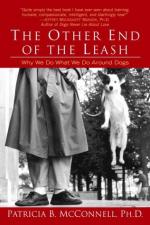
|
| Name: _________________________ | Period: ___________________ |
This test consists of 15 multiple choice questions and 5 short answer questions.
Multiple Choice Questions
1. According to McConnell, both humans and dogs are ______and_______.
(a) Highly sensitive and shy.
(b) Highly oral and shy.
(c) Highly oral and social.
(d) Highly visual and social.
2. Why do wolf and canine packs use "hip slams" and "shoulder slams"?
(a) To stake out their territory.
(b) To appear larger than they are.
(c) To hide their fear.
(d) To entice the opposite sex.
3. How should a person greet a new dog so as not to appear aggressive or rude?
(a) Crouch down.
(b) Lean back.
(c) Step forward.
(d) Hold out a hand.
4. What is the vomero-nasal organ on a dog?
(a) It is a structure that smell molecules can't stick to.
(b) It is a structure that lets in smell molecules.
(c) It is a structure that scent molecules stick to.
(d) It is a structure that closes off smell molecules.
5. Studies prove that who can tell that a shirt has been worn by a man or woman?
(a) Primates.
(b) Humans.
(c) Cats.
(d) Dogs.
6. Can dogs sniff out land mines and cancer?
(a) Yes.
(b) No.
(c) Only when a dog has matured.
(d) Only during certain months.
7. What have scientists observed as the one crucial difference between primates and humans?
(a) Imagination.
(b) Intelligence.
(c) Speech.
(d) Socialization.
8. What ingrained behavior is considered affectionate for humans but rude for dogs and should be avoided?
(a) Kissing.
(b) Hugging.
(c) Rubbing.
(d) Talking.
9. What myth do humans perpetuate about dog's regard for them, according to McConnell?
(a) That dogs give humans "unconditional negative regard."
(b) That dogs give humans "conditional negative regard."
(c) That dogs give humans "conditional positive regard."
(d) That dogs give humans "unconditional positive regard."
10. What is "doggie play bow"?
(a) Slightly crouched stance.
(b) Spreading feet apart.
(c) Touching hands on the ground.
(d) Kneeling on the ground.
11. How do male and female humans engage in play fighting?
(a) Females tend to play fight more.
(b) Neither males nor females engage in play fighting.
(c) Males tend to play fight more.
(d) Males and females engage in play fighting equally.
12. How many animal handlers has McConnell researched for her book?
(a) 202.
(b) 37.
(c) 104.
(d) 16.
13. How many languages do the animal handlers McConnell researches use?
(a) 104.
(b) 202.
(c) 16.
(d) 37.
14. How does McConnell respond to the dog when it lunges at her in front of an audience?
(a) She pets the dog.
(b) She yells at the dog.
(c) She kicks the dog.
(d) She retreats from the dog.
15. According to McConnell, humans are "living, breathing _____machine guns."
(a) Olfaction.
(b) Verbal.
(c) Tactile.
(d) Aural.
Short Answer Questions
1. What is a dog pushing the corners of her or his mouth back a sign of?
2. If an owner wants to encourage movement in a dog, what should she or he do?
3. What do dogs equate loudness to?
4. How conscious are dogs of their pheromones?
5. Why does commanding "down" for a dog to lie down and "down" for a dog to get off the couch confusing?
|
This section contains 514 words (approx. 2 pages at 300 words per page) |

|




